
White Cricket Ball, Red Cricket Ball, and Pink Cricket Ball, What’s The Difference?
Since its inception in the gentleman's game, cricket has gone through a lot of changes in rules and gameplay. This often sparks the debate as to whether the game has either become tougher and the regulations stricter, or has it changed for the worst. Changes are inevitable, and this change helps evolve the game into an exciting and extravagant affair of rivalry and sport.
Just like these white-collar changes, there are plenty of superstitions and beliefs that the politics along with many other miscellaneous affect the team's spirit and overall gameplay. One of the most popular misconceptions people have is if the type of ball used in a particular game has a different effect on the players and game.
Many believe that the type of ball plays a major role, whereas some claim that the ball has nothing to do with the game. To get rid of these assumptions and false narratives, we will take a dive into the different types of cricket balls, how they are manufactured and how they affect the game.
A cricket ball is single-handedly the most important part of the game, without which there is no cricket. Traditionally cricket was always played with a red cricket ball, but there have been records of arguments and requests to change the colour of the ball since 1937. Eventually, as the game got more structured, the use of white cricket balls became more popular.
The white balls were introduced to the game and were exclusively being used in ODIs, and T20 matches. Shortly after that, a few matches started utilizing the green ball as well. Red, white and pink cricket balls got filtered for specific games the main reason being, that in yellow floodlights, the red ball becomes slightly brownish, hence camouflaging with the pitch. White and pink balls are now used for such games.
A cricket ball’s core comprises a cork, which is tightly wound by strings that later get covered with a leather case, that has a slightly raised sewn crease. Let us explore what these balls are made of and how they are manufactured.
How are Cricket balls made?
If you have ever heard true cricket enthusiasts talk then you might have come across the term "the sound of leather on willow", this is a very popular cricketing cliche. The cricket ball has a hard exterior that makes the spherical shape around the cork at the core of the ball.
Beneath the layers of these hard leather sheets, a chunk of cork is placed as the core. The cork piece is spun around strings that tightly wound the cork and slowly form a bigger spherical shape.
Then all the components are weighed and checked according to the universal standards of the cricket ball i.e 155.9 -163.0 grams. Soon after the weighing, a specific leather is selected and cut into four pieces. These pieces are placed together covering the string-spun chunk of cork, and then the ball is stitched around the “equator” of the ball. This stitch forms a raised seam, which helps players grip the ball. Read about 4-piece Vs 2 Piece cricket ball.
The final stage of this process is to choose a dye for the wrapped leather. The three main dyes that are widely used are white, red and pink. Once the dye is finalized the ball is stamped with the manufacturer's company name and several coats of polish are applied to the ball.
So, hope now you understand what the cricket ball is made up of.
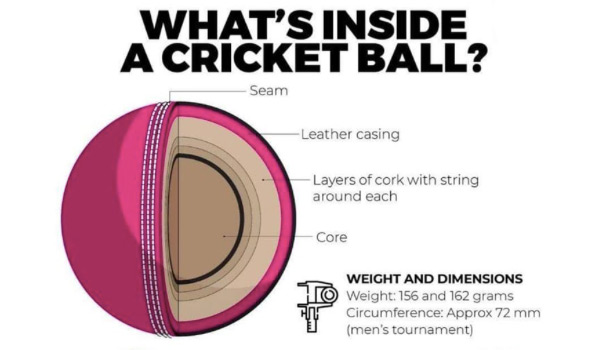
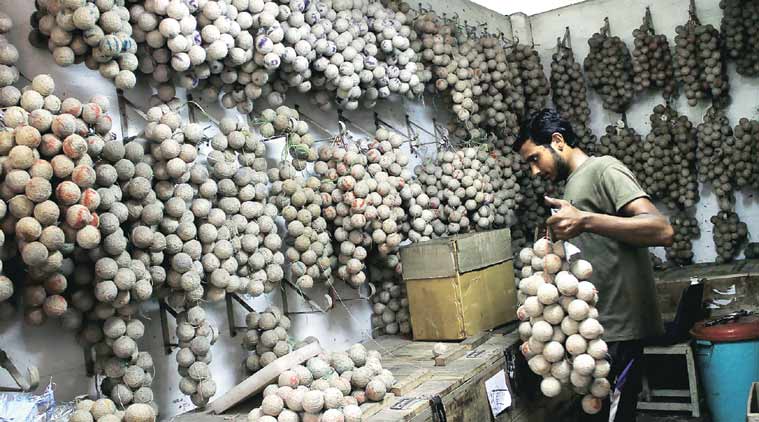
Difference between the red, white and pink balls
Red vs White
Cricket was initially played with a red ball until matches started getting more time-bound and specific. Today the red cricket ball is used during test matches whereas the white cricket ball is popularly known to be used in T20 and ODIs. The weight of the white ball or test cricket ball is the same. Over the years, many enthusiasts have done legitimate analysis and research on how the ball affects the game.
Crickets experts have concluded the following from intensive research and observation:
1. White balls were first suggested only because of the visibility aspect of the game. Dark red balls were not visible during matches that went on for a longer period of time. The white ball was later widely accepted by the audience as well since viewers found that they could follow the game better than before. The white really pops on the screen and is even visible distinctly from a distance. White cricket leather ball used in IPL too.
2. Experts say that the white ball is generally more polished than the red one to make it shinier and visible on the field. This shine comes from the extra coat of polish on the surface of the ball. This smoothness actually removes a lot of resistance from the generic red ball and thus, swings more compared to its red and pink counterparts.
3. Since the white ball has a finer and smoother finish, the surface of the ball becomes a little harder than that compared to a red or pink ball. This does not have a major effect on the game but many bowlers have used this trait of the ball to their advantage.
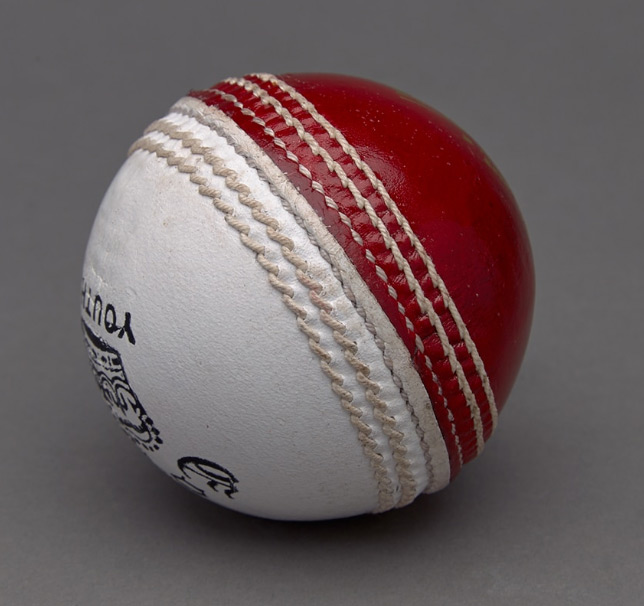
Red vs Pink
The red and pink cricket balls are not that different from each other. Visibility is the main concern of people, pink balls have been introduced in long test matches.
Both the balls are manufactured in the same process and materials, the following are the main differences between the two balls.
1. Since both pink and red cricket balls are manufactured in the same way, there is no difference in its core component, or in the stitched process. One of the most notable differences is that the red ball is stitched with white thread while the pink ball is stitched with black thread.
2. Wax is applied to the red ball to make it shinier. This helps bowlers reverse swing the ball by constantly rubbing and maintaining one side of the ball. Apart from the swing, the wax only gives the red ball its cherry color. But the same wax makes the pink ball change its colour to black. That’s why a PU-based coat is used on the pink ball to make it look brighter.
3. There is a noticeable difference in the seams of the two balls. The seam of the pink ball is more firm and pronounced, it helps the players grip the ball properly. The seam material is an equal mix of synthetic and linen. Whereas the seam of the red ball is purely synthetic. This manufacturing difference is maintained due to the time of the game. Because red balls are used in games that end before the sun sets, whereas pink cricket balls are used in games that often start at noon and go on until dark.
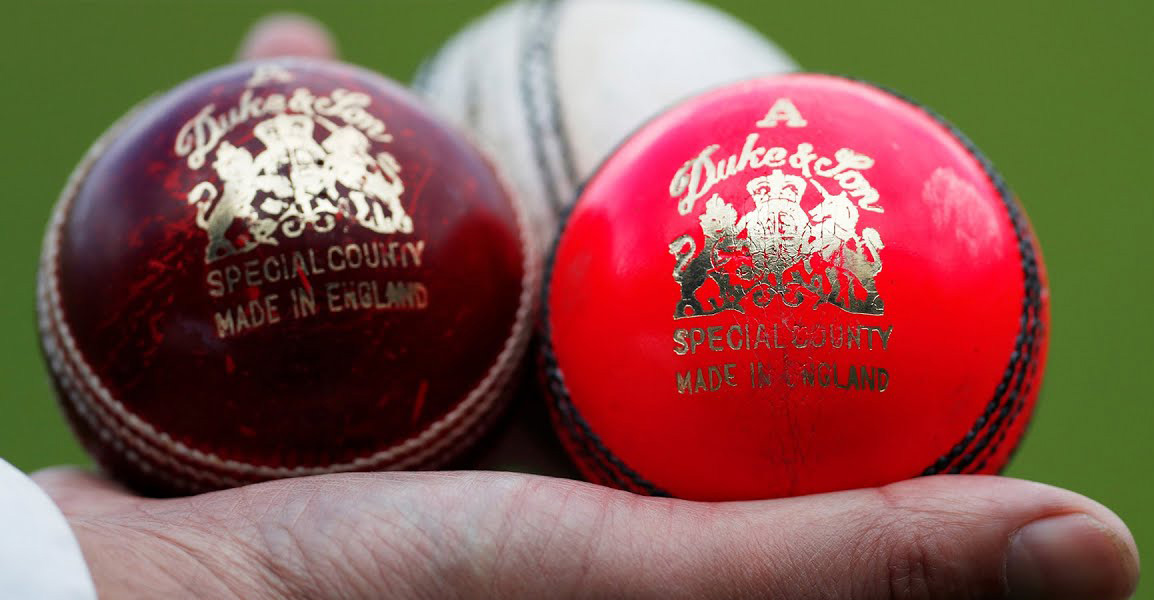
White vs Pink
The white and pink balls are more similar than they seem. The whole point to choose these two colours was for the visibility of the ball during dark conditions (or where there are yellow floodlights). The pink ball has been recently introduced to test games and is slowly finding its way into ODI and other matches.
1. The white ball and the pink ball have slightly different seams. Just like the red ball, the seam of the white ball is crisper and fully synthetic. This helps with the grip of the ball. But the seam of the pink ball is a mixture of linen and synthetic.
2. The white ball requires a lot of polishing and coating. This makes the white ball a little heavier than the red and pink balls. Because of its smooth surface, the white ball swings well. The pink ball, however, is not polished as much as the white one and is lighter than its counterpart. This makes the pink ball swing even more than the white and red ones.
The pink ball has arguably been debated upon, whether the ball will change the course of the game or not, but only time can give us more accurate conclusions.
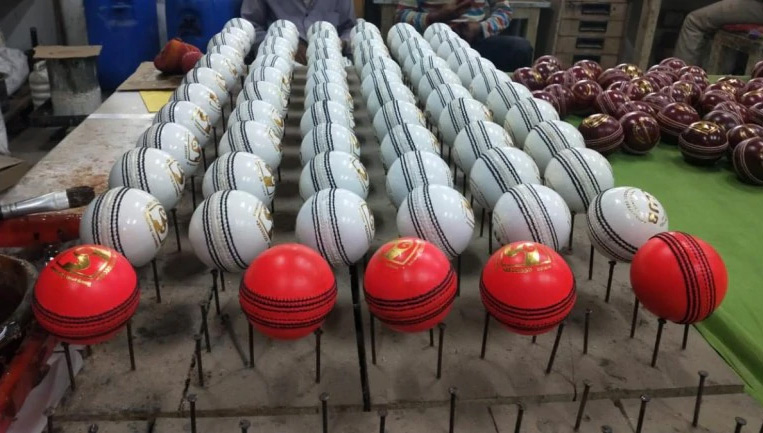
Pros and Cons
Red ball
Pros
- The red ball has a distinct and crisp seam as compared to the white and pink balls.
- The red ball is lighter than the white ball, and hence ballers can use it to their advantage at times.
- The cherry red colour of the cricket ball makes it more useful during any match that happens during day time.
Cons
- The red ball only has one layer of wax coating on the surface making it more vulnerable to the simple wear and tear of the game, so the red cricket balls normally wear out very soon.
- The red balls become hard to locate and sometimes even take on a brownish hue when exposed to yellow-white floodlights. This makes the ball camouflage in with the pitch making it hard for players to use it during the night time or dark conditions.
White ball
Pros
- The white ball is smoother and has a better texture than the red and pink balls. Due to the polyurethane coating, the surface of the ball becomes finer making it prone to swing at an early stage.
- The visibility of the white ball is uncanny, thus it is used during ODIs and T20s.
- Because the white ball is vulnerable to wear and tear as well, the more it wears out, the better the white ball can give a reverse swing.
Cons
- The white ball is a little heavier than the red and pink ball making it hard to control at times (relatively).
Pink ball
Pros
- The pink ball can endure more wear and tear as compared to its white and red counterparts.
- The pink ball swings more than the white ball and hence is very advantageous for bowlers.
Cons
- The pink ball is a bit tough on the batsmen, many have complained that the batsmen find it difficult to spot the ball from the audience due to its unique colour.
- Wax cannot be applied to the pink ball, ordinary wax makes the pink ball darker in colour which can be a problem for players playing in an evening time slot. Thus, a different coating is applied to the pink ball to make it more bright, and yet more distracting.
Kookaburra is the leading manufacturer of cricket bats and balls, they specialize in making all sorts of sports equipment but are widely known for their cricket balls. especially Kookaburra Turf Cricket ball which is also used in international cricket matches. They claim that the manufacturing process for the white and red balls is the same, only different leather materials are used and the white ball is polished more. None of these is meant to have an adverse effect on the cricket game.
Dukes, Kookaburra and SG Cricket balls are very good balls and that's why these are used in international matches, but these balls are out of the budget of many players playing for colleges, clubs so alternate are SF Cricket balls and AJ cricket balls (All Just Sports) which are also very good leather balls and in the budget.
Conclusion
Cricket is indeed one of the most interesting games in the world. Even the slightest change in the rules and regulations has a lot of potential to change the gameplay. The whole point of using a brightly coloured ball was only the problem of visibility when it comes to games played after dark. But as the organization is evolving so is the sport, and so are the explicit details of this game-changing into a much more interesting structure of the game.
Different colour balls have been occasionally experimented with during games. Yellow and orange-coloured balls were used as an alternative to white balls during night times, but the colour has been rejected from the game and has not been used ever since, to this the pink ball has made its debut and is actually being preferred over any other ball right now.
Bowlers have ever since learned to use different types of balls to their different advantage. Though new standards will be set with new regulations, the whole spirit and intensity of the gentleman's game can never really change.
If you planning to buy cricket ball online then till now you are already aware "We" are the masters and knows the craft of delivering genuine leather cricket balls to your home.
Learn About
- Understanding Imperfections & Grains in English Willow Cricket Bat
- How to do Maintenance of a Cricket Bat
- 6 Tips for How to Choose a Cricket Bat That's Right for You
- Indian Premier League (IPL) and 10 Interesting Facts
Your email address cannot be published. Required fields are marked*

 My Account
My Account Track Order
Track Order Sports Guide
Sports Guide
